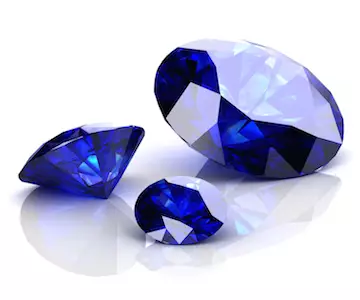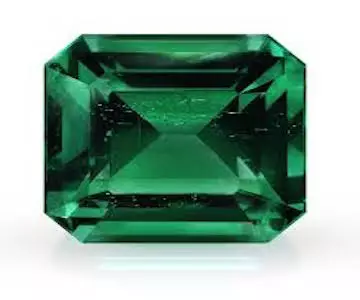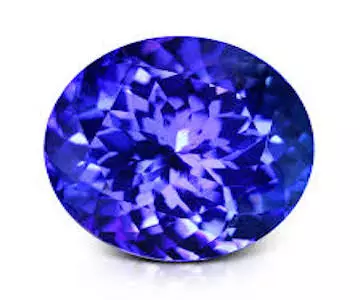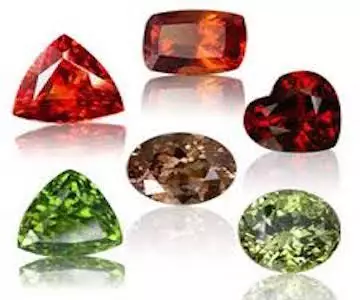Gemstones
The gemstone is given its status in line with its 4C ranking, just like a diamond.
Color
The Gemological Institute of America states that there are a total of 31 gemstone hues and six grades of gemstone saturation. The tone of a gemstone is dictated using a universally recognised 0-10 scale. The most valuable stones are those with a single pure hue and only very small dashes of extra hues.
The color is perhaps the most significant attribute for gemstones, particularly when it comes to picking out the best quality stones. In fact, gemstone color is actually made up of three distinct attributes; hue, tone, and saturation. Whilst hue contributes the most to the color of a stone, saturation describes its intensity of color (how bright it is), and tone describes its place on the scale of saturation (so, for example, whether it is a dark version of green or a pale one).
Clarity
The typical gemstone has the potential to exhibit a range of blemishes and inclusions. Yet, the presence of these two characteristics is of less interest than their respective positions and levels of visibility. For example, the most concealed inclusions are the ones which sit beneath the bezel facets and can be found close to the girdle.
The range of clarity for gemstones spans from VERY VERY SLIGHTLY INCLUDED (also known as VVS) to INCLUDED 3 (or I3). The VVS title is placed on stones which have no inclusions or inclusions which are too small to identify, even under a magnifying glass. The I3 title is placed on stones with very clear inclusions. If a stone has many inclusions, they tend to have detrimental impact on clarity and value.
The gemstone can be included in one of three classifications. The first grouping is made up of gemstones which do not have any inclusions (for example, amethyst, citrine, and zircon).The second grouping is made up of gemstones which have a handful of inclusions or blemishes (for example, sapphire, spinel, and ruby). The third and final grouping is made up of gemstones which are almost exclusively ‘included’ (for example, red tourmaline and emerald).
Cut
The gemstone is usually cut to make the color more prominent. However, characteristics like brilliance, polish, symmetry, and carat are also taken into account when deciding how to cut for maximum value. A stone can be cut either cabochon or faceted; the choice generally depends on the combination of factors outlined above. For instance, clear stones are usually cut in a faceted style, because the process makes the most out of their brilliance.
On the other hand, opaque stones are usually cut in a cabochon style, because the process highlights their color and increases value. If a gemstone has a very saturated color, it might also present a shallower cut – and vice versa, gemstones with a reduced color saturation usually present a deeper cut. The objective is to create a gemstone which is well balanced and cut symmetrically, because these are the stones which sell for the highest price.
Carat Weight
The higher the carat weight, the more valuable the stone (as long as it also has a pleasing clarity, color, and cut). It is important to note that the carat weight is not equivalent to the overall dimensions of a gemstone, because the precise gravity and density factors cannot be equal for all stones. For instance, a one carat ruby is always going to be more diminutive in size than a one carat diamond, as ruby presents a higher precise gravity than a diamond.

Blue Sapphire
Sapphire” comes from the Greek word “sappheiros.” Sapphires come from the mineral corundum and come in every color but red, since red corundum is known as the other popular gemstone, ruby. Sapphiers is the birthstone of september and have been long associated with royalty and romance.If you’re shopping for blue sapphires, you’ll find the finest quality sapphires have a strong medium blue color, rather than a dark navy color or a pale pastel shade. And those that are slightly violet are more coveted than those that are slightly green.Sapphires are most common in cushion and oval cuts and are generally more affordable than the comparable quality ruby, emerald or diamond.All colors of sapphires are mined in Sri Lanka, Tanzania and Kenya. Recently, Madagascar has been an important source for blue, pink and other-colored sapphires. Kashmir and Myanmar are known to mine fine blue sapphires of high quality that are sought after by collectors since they are rare.Sapphire has a hardness of 9 on the Mohs scale, just one level below diamond in gemstone hardness.Be aware that there are sapphires in the marketplace that are “synthetic” (man-made) or “treated” (artificially enhanced, often to improve color), and these should cost significantly less than natural sapphires. Any synthetics or treatments should be disclosed by the jeweler, and a valuable sapphire should be accompanied by an independent laboratory report.

Emerald
This stunning green gem gets its name, from the ancient Greek word “smaragdos,” meaning “green stone,” and helps to celebrate those born in May as well as 20th and 35th wedding anniversaries.Emerald is the bluish green to green variety of beryl, a mineral that also includes aquamarine. Mined for thousands of years, this gemstone has adorned the elite of ancient civilizations and have been credited with magical powers. This gemstone was thought to be a protection against evil spells and a cure for diseases such as cholera and malaria. Wearing an emerald was believed to reveal the truth or falseness of a lover’s oath as well as make one an eloquent speaker.Emerald has many special qualities, they are most of all about color. Subtle variations in color make significant differences in value. Another important factor in determining an emerald’s value is the location from which it is mined. Countries like Colombia, Brazil, Zimbabwe and Zambia supply the majority of the world’s emeralds.Emeralds typically contain inclusions that are visible to the unaided eye. Because of this, trade professionals and some consumers understand and accept the presence of inclusions in emeralds. Emerald inclusions are often described as looking mossy or garden-like, and are sometimes called “jardin,” which is French for garden.Emerald is a durable gem with a hardness of 7.5 to 8 on the Mohs scale, making it great for everyday wear.

Ruby
Ruby is the most valuable variety of the corundum mineral species, which also includes sapphire.Rubies can command the highest per-carat price of any colored stone.
This makes ruby one of the most important gems in the colored stone market.In its purest form, the mineral corundum is colorless.Trace elements that become part of the mineral’s crystal structure cause variations in its color.Chromium is the trace element that causes ruby’s red, which ranges from an orangy red to a purplish red. Ruby is the birthstone for July and the gem for the 15th and 40th anniversaries.Ruby is a very hard gemstone, 9 on the Mohs scale, with only diamonds and moissanite being harder.Ruby is one of the most historically significant colored stones. Rubies are mentioned four times in the Bible, in association with attributes like beauty and wisdom. In the ancient language of Sanskrit, ruby is called ratnaraj, or “king of precious stones.”
Ruby retained its importance with the birth of the western world and became one of the most sought-after gems of European royalty and the upper classes. Many medieval Europeans wore rubies to guarantee health, wealth, wisdom, and success in love.Desire for ruby is just as great today as it always has been. As a symbol of passion, ruby makes an ideal romantic gift.

Tanzanite
Tanzanite is found in only one place on earth, near majestic Mount Kilimanjaro in Tanzania. Tanzanite’s most-prized colors are a strongly saturated pure blue or violetish blue. it was the first gemstone added to the birthstone list since 1912 by the American Gem Trade Association in 2002.Because tanzanite was only discovered in 1969, it never had a chance to be included in the official birthstone list, which was created in 1912.Tanzanite was added as it is by far the most popular blue gemstone after sapphire. which it shares Decembers birthstone.Tanzanite usually has to be large to reach a deep saturated blue or purple. Small accent stones that are less than a carat are commonly a lighter color. With a hardness of 6 to 7 and poor toughness, tanzanite is not an ideal ring stone for everyday wear.Tanzanite is available in a wide range of shapes, but cushion and oval cuts are more common.Because of its pleochroism (it shows two or more distinct bodycolors when viewed in different directions), cutting direction determines the gem’s overall face-up color.Cutting a tanzanite to emphasize the bluish purple color usually wastes less rough than cutting it to get a pure blue or violetish blue color. The cutter has to make a choice between a smaller top-color gem and a larger bluish purple one.

Aquamarine
Named after seawater, aquamarine’s fresh watery hue is like a cool plunge into a refreshing pool. Fine aquamarines are a marriage between color and clarity. The best are dark blue to slightly greenish blue with no visible inclusions. Careful cutting maximizes both qualities to produce superb gems. Most faceted aquamarines are free of eye-visible inclusions. Collectors generally expect clean gems with good transparency. There is a trend today to use included, but good-color aquamarines as unique center pieces for jewelry articles or even as partially polished crystal slices or nuggets in necklaces. Aquamarines can be cut into almost any shape, but cutters often fashion them as emerald cuts or as round or oval brilliants. Many gem artists use aquamarine for one-of-a-kind designer cuts because their styles maximize the material’s pure, even color and high clarity. The world’s largest cut aquamarine from Minas Gerais, Brazil. The Dom Pedro, named after the first Emperor of Brazil, was fashioned from the largest gem quality aquamarine crystal ever found.The amazing finished piece is nearly 14 inches tall and weighs 10,363 carats, or about 5 pounds. It is estimated to still have $5,000,000 -$6,000,000 worth of aquamarine in it.

Turmaline
Tourmalines are gems with an incomparable variety of colours. The reason, according to an old Egyptian legend, is that the tourmaline, on its long journey up from the centre of the Earth, passed over a rainbow. In doing so, it assumed all the colours of the rainbow. And that is why it is still referred to as the 'gemstone of the rainbow' today.The name tourmaline comes from the Singhalese words 'tura mali'. In translation, this means something like 'stone with mixed colours', referring to the colour spectrum of this gemstone, which outdoes that of all other precious stones. There are tourmalines from red to green and from blue to yellow. They often have two or more colours. There are tourmalines which change their colour when the light changes from daylight to artificial light, and some show the light effect of a cat's eye. No two tourmalines are exactly alike. This gemstone has an endless number of faces, and for that reason it suits all moods. No wonder that magical powers have been attributed to it since ancient times. In particular, it is the gemstone of love and of friendship, and is said to render them firm and long-lasting.Tourmalines are found almost all over the world.Tourmaline ranks 7 to 7.5 on the Mohs hardness scale.

Amethyst
Its colour is as unique as it is seductive, though in fact this gemstone of all gemstones is said to protect its wearer against seduction. The amethyst is extravagance in violet. For many thousands of years, the most striking representative of the quartz family has been a jewel coveted by princes both ecclesiastical and secular. Moses described it as a symbol of the Spirit of God in the official robes of the High Priest of the Jews, and the Russian Empress Catherine the Great sent thousands of miners into the Urals to look for it. In popular belief, the amethyst offers protection against drunkenness - for the Greek words 'amethystos' mean 'not intoxicated' in translation. A more apt stone for the month of February, particularly if there is to be plenty going on in the way of carnival celebrations, could thus hardly be wished for.The amethyst has its hardness (7), its moderate refraction and its weight in common with the other quartzes, but the crystal structure is different, and it is most unconventional.The construction is stratified, as a result of which areas and lamellae of varying colour intensity often come about. This explains why there are relatively few large cut amethysts of an evenly distributed dark colour, in spite of its having been found so abundantly in all parts of the world.World’s largest amethyst geode Originally from the north of Uruguay, the 3.27 meters tall Empress arrived at The Crystal Caves in November 2007 and two large cranes were needed to lift her into her current position.

Citrin
The name is derived from the colour - the yellow of the lemon - , although the most sought-after stones have a clear, radiant yellowish to brownish red. Like all crystal quartzes, the citrine has a hardness of 7 on the Mohs scale and is thus, to a large extent, insensitive to scratches.Citrine jewellery shimmers and brings a hint of sunshine to those dull November days.There are not many yellow gemstones in the world of jewels. A diamond or a sapphire may be yellow - those will be expensive -, or sometimes a tourmaline or chrysoberyl.However, the citrine fulfils everyone's colour wishes, from lemon yellow to reddish brown.Rare though it is, yellow does in fact occur in quartz in Nature, if seldom, when there are traces of iron in the silicon dioxide. Historically, it has been found in Spain, on the Scottish island of Arran. Perhaps the citrine wouldn't have been talked about any more at all if, in the middle of the 18th century, it had not been for the discovery that amethysts and smoky quartzes can also be rendered yellow by so-called burning. This heat treatment at temperatures of between 470 and 560 degrees has to be carried out very carefully and requires a great deal of experience. However, in the course of 200 years, its application has become so much a matter of course that most of the stones available in the trade today are in fact burnt amethysts or smoky quartzes. Only a trained specialist can recognise the signs of heat treatment at all, burnt stones having subtle stripes whilst the yellow of natural ones is cloudy.

Garnet
Garnets have been known to Man for thousands of years. Noah, it is said, used a garnet lantern to help him steer his ark through the dark night. Garnets are also found in jewellery from early Egyptian, Greek and Roman times. Many an early explorer and traveller liked to carry a garnet with him, for the garnet was popular as a talisman and protective stone, as it was believed to light up the night and protect its bearer from evil and disaster. Today, science has taught us that the garnet's proverbial luminosity comes from its high refractive index.Not only do garnets have many colours; they also have many names: almandine, andradite, demantoid, grossularite, hessonite, pyrope, rhodolite, tsavorite, spessartine, and uvarovite, to quote but a few. But let us restrict ourselves to the most important the red garnets. First, there is the fiery red pyrope. Its spirited red, often with a slight brownish nuance, was a gemstone colour much in demand in the 18th and 19th centuries. Garnets from a find in the north-eastern part of the former kingdom of Bohemia - small stones of a wonderful hue - were world-famous at that time. In Europe, they were worked into jewellery a good deal, especially in the Victorian period.And what else is there that distinguishes this gemstone group from the others? Well, first of all there is its good hardness of 7 to 7.5 on the Mohs scale. With a few minor exceptions it applies to all the members of the garnet group, and it is the reason for the excellent wearing qualities of these gemstones.

Peridot
This gemstone has no fewer than three names: 'peridot', 'chrysolite', from the Greek 'gold stone', and 'olivine', for the peridot is the gemstone form of the mineral olivine. In the gemstone trade it is called 'peridot', derived from the Greek word 'peridona', which means something like 'to give richness'.The peridot is one of the few gemstones which come in one colour only. The rich, green colour with the slight tinge of gold is caused by very fine traces of iron. From a chemical point of view, peridot is an iron magnesium silicate. The intensity of the colour depends on the amount of iron actually present. The colour itself can vary over all shades of yellowish green and olive, and even to a brownish green. Peridot is not particularly hard - only 6.5 to 7 on the Mohs scale - but it is easy to look after and fairly robust. Peridot cat's eyes and star peridot are particularly rare and precious.The most beautiful stones come from the border area between Pakistan and Afghanistan. However, the peridot as a gemstone also exists in Myanmar, China, the USA, Africa and Australia.Creative gemstone cutters have succeeded in cutting some fascinatingly beautiful one-off stones of more than 100 carats from some of the large, fine, clear crystals with their magnificent rich green.The peridot is a gemstone that you should definitely get to know better. Its fine pistachio to olive green is the perfect complement to a fresh, light summer wardrobe.The peridot is the gemstone of the month of August.

South Sea Pearl
Pearls are organic gems, created when an oyster covers a foreign object with beautiful layers of nacre. Long ago, pearls were important financial assets, comparable in price to real estate, as thousands of oysters had to be searched for just one pearl. They were rare because they were created only by chance.Today pearls are cultured by Man. Shell beads are placed inside an oyster and the oyster is returned to the water. When the pearls are later harvested, the oyster has covered the bead with layers of nacre. Most cultured pearls are produced in Japan. In the warmer waters of the South Pacific, larger oysters produce South Sea cultured pearls and Tahitian black cultured pearls, which are larger in size. Freshwater pearls are cultured in mussels, mostly in China.The quality of pearls is judged by the orient, which is the soft iridescence caused by the refraction of light by the layers of nacre, and lustre, the reflectivity and shine of the surface. Fine pearls do not have any flaws or spots in the nacre: it has an even, smooth texture. Other factors which affect value are the regularity of the shape, size, and colour: rose tints are the most favoured.Cultured and natural pearls can be distinguished from imitation ones by a very simple test. Take the pearl and rub it (gently!) against the edge of a tooth.Cultured and natural pearls will feel slightly rough, like fine sandpaper, because of the texture of natural nacre. Imitations will feel as smooth as glass because the surface is moulded or painted on a smooth bead.

Fresh Water Pearl
A freshwater pearl is a pearl that is cultured in a mussel in a lake, whereas the traditional cultured pearl is cultured in an oyster in the ocean (salt water pearls are called Akoya pearls). Freshwater cultured pearls are less expensive than the Akoya pearls.They are easier to grow than salt water pearls; one freshwater mussel can grow a multitude of pearls at a time, compared to salt water oysters that usually produce only one pearl. That said, the cultivation of Freshwater pearls is still a labour of love; mussels are often cultivated in farms in southern regions where pearl formation is faster, and then moved to northern farms (that have slower cultivation) to produce a compact nacre for better colour and lustre.Freshwater pearls are quite possibly the most versatile variety of pearls produced today. They grow in nearly every conceivable shape, the widest range of sizes, and exhibit a palate of pastel colors ranging from dark purple, to light pink and white, as well as uncommon exotic and metallic colors. Freshwater pearls grow predominately in China, and to a much lesser extent in Japan. While the most commonly produced shapes are baroque, a very small percentage, less than 2% of total production, are considered round or very near round.Although freshwater pearls are often considered to be the lower-value pearl variety at this stage in time there are no freshwater pearl farms in Australia.
